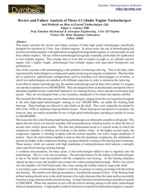Papers
“Review and Failure Analysis of Three 4 Cylinder Engine Turbochargers,” |
Abstract
This paper concerns the review and failure analysis of three high speed turbochargers specifically designed for operation in 2 liter, four cylinder engines. In recent years, the use of turbocharging has become extremely popular, with applications ranging from large diesel engines, to various eight, six and four cylinder engines. The use of these turbochargers has greatly expanded, particularly for application to four-cylinder engines. The concept, then is to be able to replace an eight or six cylinder, heavier engine with a lighter weight, turbocharged four-cylinder engine with equivalent horsepower and performance.
One of the concerns with turbocharging is the problem of reducing turbo lag. This is the delay often experienced by turbochargers in coming up to speed, producing an irregular acceleration. This has often led to expensive, sophisticated configurations such as installing twin turbochargers, or bi-turbos, in which two turbochargers are installed with different capacities in order to minimize the turbo lag. In an effort to reduce turbocharger lag, the modern turbocharger used in these four cylinder 2 L engines can operate at speeds of over 200,000 RPM. They are designed from an aerodynamic standpoint to have minimum impeller inertia, small shaft diameters, low bearing friction, and to operate at extremely high speeds. They are not designed from a rotor dynamics standpoint to be robust and operate stability. The standard fluid film bearings used in these turbochargers, ranging from the very large diesel engines to the ultra high-speed turbochargers running at over 200,000 RPM, are called the floating bush bearings. These bearings are allowed to spin freely on the shaft. They were originally developed by GM in the 1930s to minimize bearing friction losses. These bearing are inexpensive to produce, but however, they are totally unsuitable for use in high-speed turbochargers operating at speeds in excess of 200,000 RPM.
The reason for this is that floating bush bearing turbochargers are inherently unstable at all speeds! This means that the rotors can become unstable with nonsynchronous whirling motion in either the first or second rotor critical speed modes. The first and predominate mode is a conical mode in which the compressor impeller is whirling out-of phase to the turbine wheel. In the higher second mode, the compressor impeller is whirling in-phase with the turbine impeller, but with a larger amplitude of motion. Since the steel turbine impeller is heavier then the aluminum compressor, the amplitudes of motion are higher at the compressor bearing, causing enhanced wearing of the bearing inner clearance. These modes, which can operate with high amplitudes of subsynchronous whirl motion, eventually cause significant bearing wearing damage.
A common misconception, for many years, is that turbochargers failed to due to ingestion into the turbocharger. This is a very rare occurrence. The principal reason for the failure of all turbochargers is due to the initial wear encountered with the compressor end bearing. As this bearing clearance opened up due to wear, the impeller may contact the volute causing blade damage. With a very severe rub, the impeller will whirl backwards, like a top causing the turbine wheel to snap at the shaft. A secondary cause of turbocharger failure is with the occurrence of coking occurring with the turbine end bearing. The turbine end bearing encounters a considerable amount of heat. If the floating bush turbine bearing should seize to the shaft because of its tight clearance then the outer surface essentially becomes a large clearance plain journal bearing. A large clearance journal bearing is unstable at speeds of 5000 RPM. When this situation occurs with the turbine bearing seizing to the shaft, turbocharger failure is instantaneous. A high quality synthetic lubricant is required for these turbochargers to operate.

